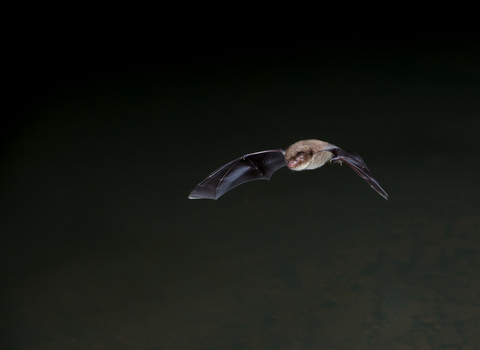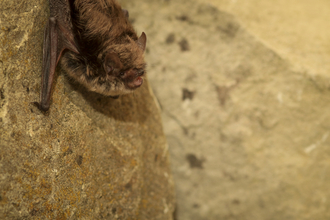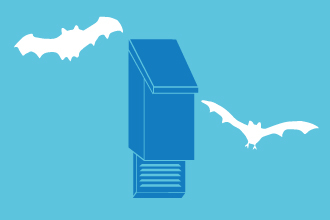Bats
Flitting out of the rising darkness like shadows, these nocturnal mammals are as charismatic as they are misunderstood. Britain is home to 18 species of bat, the largest being the noctule which weighs as little as four £1 coins, and the smallest, the pipistrelle, weighing as little as a 2p coin, is known to gobble up more than 500 insects in an hour! Whether you are watching them in woodlands or skimming over a river, the sight of a bat quickens the heart.
Being buzzed by a bat is a wildlife experience not to be missed
Find bats near you
Do a little research in advance and find out where you can see bats hunting as the daylight fades. Here are some of the best spots from around the UK.
North
Durham Wildlife Trust
Low Barns Nature Reserve near Witton-le-Wear is a great place to experience bats. This SSSI woodland, wetland and species-rich grassland habitat provides perfect roosting and foraging habitat for soprano pipistrelles, common pipistrelles, noctules and Daubenton’s.
Visitors to the reserve can watch soprano pipistrelles as they emerge from their roost above the visitor centre entrance, while the Daubenton’s feeding above the River Wear, which runs through the reserve, is another nightly event not to be missed.
Lancashire Wildlife Trust
Boilton Wood (at Brockholes) - is one of the last remaining areas of ancient woodland in Lancashire and its main path (pictured) is a highway for bats as well as walkers. Both soprano and common pipistrelle use the path and they are joined by noctule and Daubenton's. The latter also make great use of the nearby lakes of Brockholes nature reserve and paths from Brockholes make access to Boilton easy.
Boggy ground around the wood is a breeding ground for insects, which offer a wonderfully diverse buffet for the bats. The woodland has a wide range in ages of trees, offering plenty of shelter for the bats and their young.
Aren't able to travel to Boilton Wood? Other Lancashire bat 'hot-spots' are:
Northumberland Wildlife Trust
Big Waters is the largest subsidence pond in the region, formed by the collapse of deep mine workings. The presence of the large lake and a smaller one means that this is a haven for bats, as they can forage over the water’s edge and in the trees and grasslands around them.
Weetslade Country Park - A former colliery site, this reserve has been extensively landscaped to create a wildlife haven on the edge of the city with a hill, grassland, scrub, reedbed and woodland areas, which offers a range of habitats for bats. It's also a great reserve to see birds, such as grey partridge, meadow pipit and skylark.
Tees Valley Wildlife Trust
Margrove Ponds - This wetland nature reserve is one of the best places to see bats in the Tees Valley. The site includes a variety of habitats, including a main expanse of open water, which is surrounded by fenland, with dense beds of common reed and reedmace.
The surrounding woodland, hedges and farmland helps to increase the diversity of wildlife found here. Noctule and pipistrelle can be seen here, especially along the path and old railway line, with Daubenton's feeding over the ponds.
South
Avon Wildlife Trust
Browne's Folly - This reserve is a fantastic place to see bats, with 13 species now found here. It is, however, particularly famed for the threatened greater horseshoe bat, as the old mines offer a place of quiet sanctuary.
Standing high above the river Avon, with commanding views towards Bath, Browne's Folly boasts flower-rich grasslands and ancient woodland on the remains of old Bath stone quarries, which has been designated as a SSSI.
Berkshire, Buckinghamshire & Oxfordshire Wildlife Trust
Finemere Wood - Finemere is a magnificent woodland – home to birds, bats and butterflies, where you can forget the stresses of everyday life. This is a well-surveyed woodland, with the North Bucks Bat Group carrying out funded work, including ringing Bechstein's bats. This rare and secretive species of bat relies on the presence of tall trees, where they seek out insects to pluck from branches and leaves.
This is a great reserve to learn more about bats, as there is an interpretation board with information on some of the bat species that can be seen at this reserve.
Devon Wildlife Trust
Bystock Pools - Devon Wildlife Trust's Bystock Pools nature reserve, with its mixture of woodland, heathland and open grassland, has records of many bat species, including noctule, serotine and lesser horseshoe.
A great time to visit is during East Devon Heath Week, at the end of July, when volunteers lead evening walks to see and hear bats, as well as nightjars and glow worms. Make sure you bring your binoculars as this reserve is also great for birds. Head to the heathland to spot willow warblers, blackcaps and stonechats.
Hampshire & Isle of Wight Wildlife Trust
Barton Meadows - Barton Meadows Nature Reserve consists of two meadows that sit proudly in the heart of Winchester. A circular path around the reserve and a series of locally-produced benches offer excellent views across the rolling landscape. There are 12 species of bat that have been recorded here!
Midlands
Derbyshire Wildlife Trust
Hilton Gravel Pits SSSI - This special nature reserve is an old gravel pit that has been restored for wildlife. In the early evening Daubenton’s bats swoop, twist and turn over the large open pools, putting on a great show! The first babastrelle bat in Derbyshire was also recorded here. Take a bat detector down and see how many you can find.
As well as bats, this reserve is a haven for wildfowl, with the ponds attracting tufted ducks and great-crested grebe. A streak of blue flashing across the water will alert you to the presence of a kingfisher.
Warwickshire Wildlife Trust
Brandon Marsh - Brandon Marsh Nature Reserve is set in 220 acres and features a wide variety of large pools, bird hides, woodland walks and wildflower meadows. This former quarry has been transformed into a European Site of Special Scientific Interest (SSSI) - home to a number of iconic species including kingfisher, cuckoos and otter. The reserve is also frequented by visiting osprey, pied flycatcher and other rare migratory species. The Visitor Centre is a great place to start your visit, and includes a tea room and well-stocked gift shop. The accessible network of paths and boardwalks allow visitors to explore pools, reedbeds and woodlands and get closer to nature.
Oakley Wood - Beautiful woodland in spring and summer with wildflowers and butterflies. There has been woodland here since way back in the 16th Century but much of it was replanted with Scots pine. There are now large areas of conifer with some broadleaf trees and scrubland mixed in. Warwickshire Wildlife Trust have longer term plans to restore the wood back to native broadleaf trees.
Ryton Wood - One of the country's largest surviving semi-natural ancient woodland. In Spring primrose, wood anemone and yellow pimpernel carpet the woodland floor. The rides though the wood are grassy and bright, bringing extra light for plants such as barren strawberry and common spotted orchid. Broad-leaved helleborine grows well at the dappled edges of the rides. In the large, clear glades there are fabulous bluebell displays.
East
Essex Wildlife Trust
Hanningfield Reservoir - Between April and October, 400-500 Soprano pipistrelle bats gather in the roof of the visitor centre in a natal roost. Essex Wildlife Trust run a number of events for the public to experience the spectacle of the bats emerging at dusk, with bat detectors to allow visitors to listen to the bats.
Belfairs Woodland Centre - Led by the Centre Manager, skilled staff help people access the fantastic natural and cultural heritage of this area. The Education and Community Officer works with schools to provide forest education within the woodlands, where children learn about the environment, wildlife and nature and gain practical skills, and organises events, indoors and outdoors, for all the family to enjoy.
Hertfordshire & Middlesex Wildlife Trust
Panshanger Park is made up of a mosaic of habitats including woodlands, wetlands, grasslands and reedbeds making it a fantastic refuge for a huge variety of wildlife. Pipistrelles can be found in the wooded areas of the park and Daubenton's hunt for insects over the lakes. Panshanger Park is a 1,000 acre site owned by Tarmac, of which 200 acres is currently open to the public. The Trust is working with Tarmac and Herts County Council to manage the park for both people and wildlife.
Wales
North Wales Wildlife Trust
Gwaith Powdwr - This nature reserve is a fantastic example of a place where wildlife can thrive in a post-industrial setting. Gwaith Powdwr was once the biggest explosives works in Europe. It was donated to the North Wales Wildlife Trust by ICI in 1998 and is now managed as a nature reserve.
The best place to see bats at the reserve is at the 'Settling Pool'. Species most likely to be seen there are Daubenton’s and pipistelles, but noctules, brown long-eared and lesser horseshoes have also been recorded on the reserve. The perfect time of the year is visit is June-July, when there's also the chance to hear nightjars churring and catching a glimpse of glow-worms.
Radnorshire Wildlife Trust
Bailey Einon is an ancient woodland, which runs alongside the River Ithon. This reserve is a good place to spot Daubenton's feeding along the river. Try watching from Shaky Bridge, adjacent to the reserve entrance, or follow the boardwalk trail and go down the steps to where the path runs close to the river. Other wildlife to keep a look out for here includes otter, cardinal beetles, early purple orchids and buzzard.
Scotland
Scottish Wildlife Trust
Falls of Clyde - The 16th century ruins of Corra Castle provide a perfect roosting spot for pipistrelle and Daubenton’s bats. Natterer’s and whiskered bats have also been recorded on this reserve, which is famous for spectacular waterfalls and scenic woodland walks. The Trust holds regular bat and badger walks throughout the year, which are not to be missed.
Northern Ireland
Ulster Wildlife
Glenarm Nature Reserve in the Glens of Antrim is home to all eight species of bat found in Northern Ireland, as well as being a beautiful nature reserve. Take a bat detector along and see how many species you can find.
Islands
Alderney Wildlife Trust
Longis Nature Reserve - Walking through the reserve's coastal trails you may glimpse rare plant species such as Small Hare’s-ear, Sand Crocus, Bastard Toadflax and Orange Bird’s-foot, as well as the endemic Alderney Sea Lavender on the rocky shore. Two bird hides overlook the reserve’s freshwater ponds, offering unrivalled views of waterfowl, songbirds and migrants alike.
Alderney Community Woodland - The ACW is the result of many thousand of years of human activity on the island. Historic features, built heritage and a variety of habitats and wildlife come together in its 17 hectare area to create a unique and diverse landscape. By forming the ACW 2% of Alderney's area has been planted with native broadleaf trees.
Isles of Scilly Wildlife Trust
Bats can be seen feeding and are active all year round in Scilly
What to look for
Bats are most active in the summer months when they come out of hibernation, hunt insects, give birth and raise young, and the best time to see them is around sunset or sunrise when it is warm and dry. While some bats fly relatively high, others are found closer to the ground – not venturing far above the trees or flying low over grassland and water. To really experience the bat’s world it’s worth borrowing a special detector to hear the high-frequency clicks and buzzes of bats using echolocation to hunt. Not only will you be able to hear how many bats are around you, but the frequency of the calls lets you identify bats in the dark!
If you can't get to these places
Although the sites listed above are great places to enjoy bats, you can still experience these beguiling creatures close to where you live, whether it is in the countryside, town or city. All British bats eat insects and by following a few easy steps to make your garden wildlife-friendly, you might be able to make the bats come to you.
More wildlife experiences
From seeing colourful wildflowers to spotting magnificent birds of prey, we can help you get closer to wildlife across the UK.







